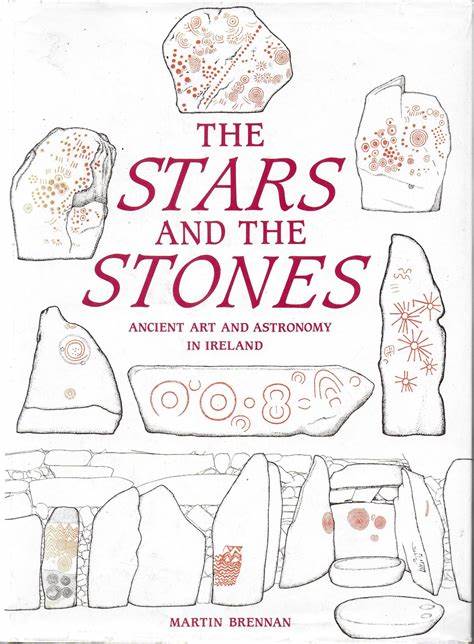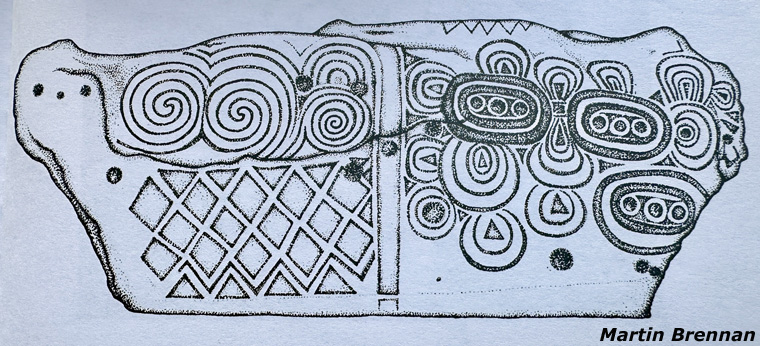Stories of the Stars and Stones
 I am dismayed by several aspects of Mrs O'Kelly's review of Martin Brennan's
book: The Stars and the Stones (Sunday Tribune, 4 December 1983).
I am dismayed by several aspects of Mrs O'Kelly's review of Martin Brennan's
book: The Stars and the Stones (Sunday Tribune, 4 December 1983).
Since I am mentioned in Martin Brennan's book, I must offer some clarification. I am not a professional archaeologist, but have been investigating prehistoric structures since 1930. (I do have a university degree in a different field.)
If Prof O'Kelly had only published his 1967 observation of the beam of rising sun lighting up the sun-symbol in the cairn of Newgrange at winter solstice, perhaps after having checked it out for the rising full moon at summer solstice doing the same thing, perhaps after watching rising suns through a year or two, then he could have been in the forefront of the new science, archaeoastronomy, along with Alexander Marschack, Owen Gingerich, Aveni, and the other distinguished leaders of the field.
Since Prof O'Kelly made that observation, he could have gone on to see what so many of us now see very clearly, a Neolithic science of rather sophisticated (by modern standards) practice of astronomy, applied to calendar-keeping (every local tribe doing its own), and sun-dialling. I am very disappointed that he did no do this.
None of this in any way decreases the achievement of dedicated, skilled and scientific archaeologists such as Prof O'Kelly, Mrs O'Kelly, Prof Eogan, and the other distinguished Irish archaeologists.
The only discrepancy is that it seems obvious to the majority of us that the stone circles and Cairns were built originally as observatories and instruction centres, and only much later misused as convenient burial sites for public personages. This is why so many of the circles have no trace of any interments.
This interpretation does not in any way contradict the findings of the archaeologists as to what went on during the Bronze Age in structures built centuries or millennial earlier.
I am dismayed that Mrs O'Kelly does not address any of the concepts elucidated in the book by Martin Brennan.
I am disappointed in Martin Brennan's book in that most of the observations made, and all the interpretations beyond the basic idea, have been withheld from print. There is so much more to the great story of Ireland's Neolithic sciences, leading the world of those times!
Mrs O'Kelly is correct in noting that Martin Brennan nor any of the rest of us, independent of Marin Brennan, seem never to meet any archaeologists in the field. The proper hours for making astronomic observations by use of stone circles and cairn passages are sunrise, sunset, full-moon-rise.
Since archaeologists seem never to work during such hours, they also never make the necessary the new science archaeoastronomy.
It is true we do rush in and out, make whatever observations we can, enjoying the benefits of prior excavations by archaeologists, and lamenting the destruction caused by their moving stones our of their original astronomic alignments here and there.
The Board of Works and the archaeologists are to be praised for the comprehensive cataloguing of ancient structures, and for posting so many of them. This is truly a great national achievement, by any scholarly standard.
It may interest you to know that archaeoastromomers have found 19 prehistoric passage cairns in the south-west United States in which the identical symbols as Newgrange and Loughcrew are carved and lighted by the incoming beams of the rising sun in the same way as shown by Martin Brennan's photographs in Ireland.
There were no burials discovered, despite vigorous search (shade of Schliemann) in these American copies of the Neolithic Irish observatories. Obviously, in both places, the original purpose was astronomic observations, not tombs. Again, Ireland leads the world, with some stone circles in Ulster carbonated by charred hazelnut shells at 9,800 or so years-old, while similar carbon dating in New Mexico and Arizona show only 1200 to 1500 years of age.
Al Morrison, Box 75 Old Chelsea, New York, US.
Mud-Grubbing
SIR, Having read Martin Brennan's The Stars and the Stones (Sunday Tribune, 4 December) most learned book on astronomy, I was horrified to see the ignorant criticism of this superb book by an archaeologist, who obviously has no knowledge of astronomy.A book on astronomy should be reviewed by an astronomer, not by an archaeologist. Would you, for example, ask an electrician to review a book on farming?
I suggest that it would widen the narrow field of archaeology in Ireland if astronomy was a compulsory subject in Irish university courses.
If they stopped grubbing around in the mud on a "9 to 5" day and tried a night shift occasionally, it would enlarge their horizons.
Sheila Lindsay, 3 Fairfield Park, Highfield Road, Rathgar, Dublin.
Boyne Valley Private Day Tour
 Immerse yourself in the rich heritage and culture of the Boyne Valley with our full-day private tours.
Visit Newgrange World Heritage site, explore the Hill of Slane, where Saint Patrick famously lit the Paschal fire.
Discover the Hill of Tara, the ancient seat of power for the High Kings of Ireland.
Book Now
Immerse yourself in the rich heritage and culture of the Boyne Valley with our full-day private tours.
Visit Newgrange World Heritage site, explore the Hill of Slane, where Saint Patrick famously lit the Paschal fire.
Discover the Hill of Tara, the ancient seat of power for the High Kings of Ireland.
Book Now
Home
| Visitor Centre
| Tours
| Winter Solstice
| Solstice Lottery
| Images
| Local Area
| News
| Knowth
| Dowth
| Articles
| Art
| Books
| Directions
| Accommodation
| Contact


